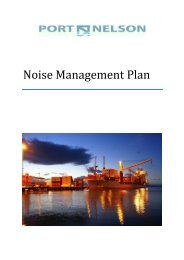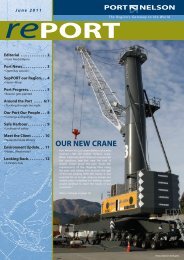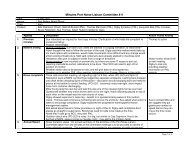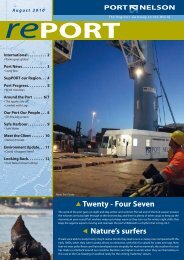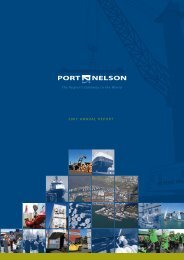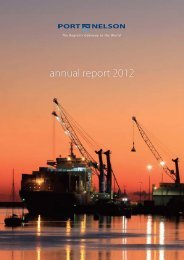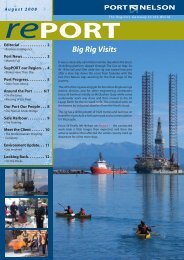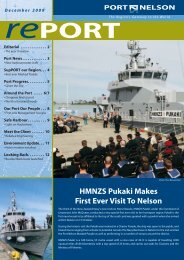April 2009 (pdf) - Port Nelson
April 2009 (pdf) - Port Nelson
April 2009 (pdf) - Port Nelson
You also want an ePaper? Increase the reach of your titles
YUMPU automatically turns print PDFs into web optimized ePapers that Google loves.
<strong>Port</strong> <strong>Nelson</strong> Limited report. <strong>April</strong> <strong>2009</strong>. Page 10<br />
meet the client<br />
Holcim (New Zealand) Ltd<br />
It’s the second ‘most used commodity’ in the world after water, and it’s delivered to our port every fortnight.<br />
The product is cement from Holcim (New Zealand) Ltd, a<br />
leading global supplier with New Zealand origins dating back<br />
to 1888. Holcim now supplies cement in bulk to ready-mix<br />
concrete and other customers using eight dedicated marine<br />
terminals at the ports of Auckland, Napier, Gisborne, New<br />
Plymouth, Wellington, Lyttelton, Dunedin and <strong>Nelson</strong>. Cement<br />
supplied to <strong>Nelson</strong> comes from Holcim’s Westport works, which<br />
have been operating virtually non-stop for the last fifty years.<br />
Tim Knight is the <strong>Nelson</strong> Depot Supervisor, and he and a<br />
tanker driver oversee the discharge of bulk cement from the<br />
two carriers, MV Milburn Carrier II and MV Westport to the 27m<br />
storage silo on Wakefield Quay, and thence around the Top of<br />
the South. The vessels visit <strong>Nelson</strong> every couple of weeks and<br />
can discharge pneumatically between 180 and 330 tonnes<br />
per hour, taking around 12 -14 hours to fill the 2800 tonne<br />
capacity silo. With both vessels making around 300 port calls<br />
each year, Tim says he really appreciates the work that goes on<br />
behind the scenes to make the berth available to the ships.<br />
“<strong>Port</strong> <strong>Nelson</strong> Ltd ties our ships up and provides services, so we<br />
have a very close relationship,” he says. “The location of our<br />
pipes means we are restricted to just one berth – so it’s a big<br />
task to fit our needs in with the rest of the shipping schedule.<br />
The port company has their own matrix to juggle and because<br />
of the nature of the business, things can change fast but we<br />
rarely have a delay and they keep us well notified.”<br />
Limestone is quarried at Cape Foulwind, processed into cement<br />
at the Westport Works, then trucked and stored in silos at the<br />
Westport wharf before being loaded on to the ships.<br />
Holcim Westport liaises with <strong>Port</strong> <strong>Nelson</strong>, and depending on<br />
the tides, the availability of the berth and the needs of other<br />
depots around the country, a schedule is worked out and Tim<br />
is notified. However, he says if there is a big job at another<br />
centre it might change the whole equation.<br />
Tim says Holcim does a fantastic job of forecasting and<br />
updating stocks everyday, and this ties into production. It also<br />
helps that concrete companies are good at giving Holcim<br />
notice of any big jobs they have coming up.<br />
Holcim and <strong>Port</strong> <strong>Nelson</strong> have a shared commitment to<br />
health and safety and environmental issues, and Tim says<br />
the company is great at keeping him informed about port<br />
activities.<br />
“As a contractor sited at the port we have monthly meetings<br />
with Cargo Operations and <strong>Port</strong> Security, stevedoring reps<br />
and others, and we are consulted about any issues that may<br />
affect our operations. For example, we were involved in an<br />
emergency plan for periphery services developed following<br />
the July 2008 storm that closed the port.”<br />
The Wakefield Quay cement silo had a makeover in 2002<br />
when Holcim New Zealand rebranded. The global brand logo<br />
of Swiss company Holderbank Cement, a stylised black H<br />
painted over a red C, replaced the previous Milburn signage. It<br />
is now one of the most visible brands on the <strong>Nelson</strong> cityscape,<br />
which is fitting, since cement from the silo has helped to build<br />
our city and our region.



